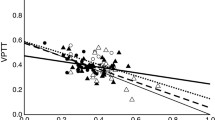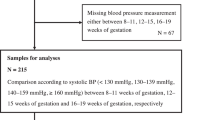Abstract
Background
Formerly preeclamptic women with a subnormal plasma vlume (PV) have an increased risk to develop a hypertensive disorder in a subseqent pregnancy as compared to women with normal PV. In the current study we tested the hypothesis that formerly preeclamptic women who develop recurrent disease in their next pregnancy differ from their counterparts with an uneventful next pregnancy by a lower pre-pregnant PV, a lower venous capacitance, smaller in these indices in early pregnancy, a lower renal adaptive response, and a lower response to mild exercise.
Patients and Methods
We enrolled 33 formerly preeclamptic women in this study. Only 14 conceived within the study period, with seven of them developing a recurrent hypertensive disorder in their next pregnancy (R[UNKNOWN]ECUR), while seven had an uneventful next pregnancy (NORM). Before pregnancy and at 12 weeks of gestational age, we compared the following variable between these subgroups: PV, venous capacitance, effective renal plasma flow (ERPF), glomerular filtration rate (GFR), and the responses in stroke volume (SV) and heart rate (HR) to mild exercise. To estimate venous capacitance, we infused 500 mL of a modified gelatine solution in 30 minutes while recording the change in cardiac output (pulse contour analysis). The ratio of percent change in blood volume to percent change in cardiac in response to a standardized small vlume load provides an estimate for venous capacitance.
Results
RECUR differed from NORM by a 20% lower pre-pregnant PV (P <.02) and venous capacitance (0.29 [0.11–0.55] vs 0.86 [0.64–2.03] P =.002). NORM and RECUR were comparable with respect to pregnancy-induced rise in PV, renal hemodynamics and function, and response to mild exercise at 12 weeks. Newborn weight correlated positively with pre-pregnancy PV (R2 = 0.53 and P =.04).
Conclusion
Formerly preeclamptic women with a recurrent hypertensive disorder in their next pregnancy differed from their counterparts with an uneventful next pregnancy by a lower pre-pregnant PV and a lower venous capacitance, the latter two indices correlating also inversely with the incidence of fetal growth restriction. The preserved acute response to volume-related stimuli in women with a low pre-pregnant PV supports the view that the predisposition of low pre-pregnant PV to adverse pregnancy outcome may result from a concomitant, PV-dependent change setpoint and/or gain in the stimulus/response interrelation of the volume regulatory system.
Similar content being viewed by others
References
Spaanderman ME, Ekhart TH, van Eyck J, Cheriex EC, de Leeuw PW, Peeters LL. Latent hemodynamic abnormalities in symptom-free women with a history of preeclampsia. Am J Obstet Gynecol 2000;182:101–107.
Aardenburg R, Spaanderman ME, Ekhart TH, van Eijndhoven HW, van der Heijden OW, Peeters LL. Low plasma volume following pregnancy complicatged by pre-eclampsia predisposes for hypertensive disease in a next pregnancy. BJOG 2003;110:1001–1006.
Aardenburg R, Spaanderman ME, Courtar DA, van Eijndhoven HW, de Leeuw PW, Peeters LL. A subnormal plasma volume in formerly preeclamptic women is associated with a low venous capacitance. J Soc Gynecol Investig 2005;12:107–111.
Aardenburg R, Spaanderman ME, van Eijndhoven HW, de Leeuw PW, Peters LL. Formerly preeclamptic women with a subnormal plasma volume are unable to maintain a rise in stroke volume during moderate exercise. J Soc Gynecol Investig 2005;12:599–603.
Spaanderman M, Ekhart T, van Eyck J, de Leeuw P, Peeters L. Prreclampsia and maladaptation to pregnancy: A role for atrial natriuretic peptide? Kidney Int 2001;60:1397–1406.
Duvekot JJ, Cheriex EC, Pieters FA, Menheere PP, Peeters LH. Early pregnancy changes in hemodynamics and volume homeostasis are consecutive adjustments triggered by a primary fall in systemic vascular tone. Am J Obstet Gynecol 1993;169:1382–1392.
Roy BD, Green HJ, Grant SM, Tarnopolsky MA. Acute plasma volume expansion alters cardiovascular but not thermal function during moderate intensity prolonged exercise. Can J Physiol Pharmacol 2000;78:244–250.
Convertino VA. Blood volume: Its adaptation to endurance training. Med Sci Sports Exerc 1991;23:1338–1348.
Bernstein IM, Meyer MC, Osol G, Ward K. Intolerance to volume expansion: A theorized mechanism for the development of preeclampsia. Obstet Gynecol 1998;92:306–308.
Bernstein IM, Ziegler W, Badger GJ. Plasma volume expansion in early pregnancy. Obstet Gynecol 2001;97:669–672.
Spaanderman ME, Aardenburg R, Ekhart TH, van Eyndhoven HW, de Leeuw PW, Peeters LL. Pre-pregnant prediction of recurrent preeclampsia in normotensive thrombophilic formerly preeclamptic women receiving prophylactic antithrombotic medication. J Soc Gynecol Investig 2005;12:112–117.
Report of the National High Blood Pressure Education Program Working Group on High Blood Pressure in Pregnancy. Am J Obstet Gynecol 2000;183:S1–S22.
van Kreel BK, van Beek E, Spaanderman ME, Peeters LL. A new method for plasma volume measurements with unlabeled dextran-70 instead of 125I-labeled albumin as an indicator. Clin Chim Acta 1998;275:71–80.
Wesseling KH, de Wit B, Weber JAP, Smith NT. A simple device for the continuous measurement of cardiac output. Its model basis and experimental verification. Adv Cardiovasc Phys 1983;5(Suppl 2):16–52.
Bernstein IM, Ziegler W, Stirewalt WS, Brumsted J, Ward K. Angiotensinogen genotype and plasma volume in nulligravid women. Obstet Gynecol 1998;92:171–173.
Spaanderman ME, Meertens M, van Bussel M, Ekhart TH, Peeters LL. Cardiac output increases independently of basal metabolic rate in early human pregnancy. Am J Physiol Heart Circ Physiol 2002;278:H1585–H1588.
Dieckmann WJ, Wegner CR. The blood in normal pregnancy. I. Blood and plasma volume. Arch Intern Med 1934;53:71–86.
Hytten FE, Paintin DB. Increase in plasma volume during normal pregnancy. Br J Obstet Gynecol 1963;70:402–407.
Spaanderman ME, Willekes C, Hoeks AP, Ekhart TH, Peeters LL. The effect of pregnancy on the compliance of large arteries and veins in healthy parous control subjects and women with a history of preeclampsia. Am J Obstet Gynecol 2000;183:1278–1286.
Waters WW, Platts SH, Mitchell BM, Whitson PA, Meck JV. Plasma volume restoration with salt tablets and water after bed rest prevents orthostatic hypotension and changes in supine hemodynamic and endocrine variables. Am J Physiol Heart Circ Physiol 2005;288:H839–H847.
Pang CC. Autonomic control of the venous system in health and disease: Effects of drugs. Pharmacol Ther 2001;90:179–230.
Peeters LLH, Buchan PC. Blood viscosity in perinatology. In: Cosmi EV, Scarpelli EM, eds. Reviews in perinatal medicine. New York: Liss; 1989:53–89.
Damron DP, Bernstein IM, Shapiro RE, Sconberg A. Uterine blood flow response to alpha-adrenergic blockade in nulligravid women of reproductive age. J Soc Gynecol Investig 2004;11:388–392.
Courtar DA, Spaanderman ME, Aardenburg R, Janseen BJ, Peeters LL. Low plasma volume coincides with sympathetic hyperactivity and reduced baroreflex sensitivity in formerly pre-eclamptic patients. J Soc Gynecol Investig 2006;13:48–52.
Author information
Authors and Affiliations
Corresponding author
Rights and permissions
About this article
Cite this article
Aardenburg, R., Spaanderman, M.E., van Eijndhoven, H.W. et al. A Low Plasma Volume in Formerly Preeclamptic Women Predisposes to the Recurrence of Hypertensive Complications in the Next Pregnancy. Reprod. Sci. 13, 598–603 (2006). https://doi.org/10.1016/j.jsgi.2006.07.008
Published:
Issue Date:
DOI: https://doi.org/10.1016/j.jsgi.2006.07.008




